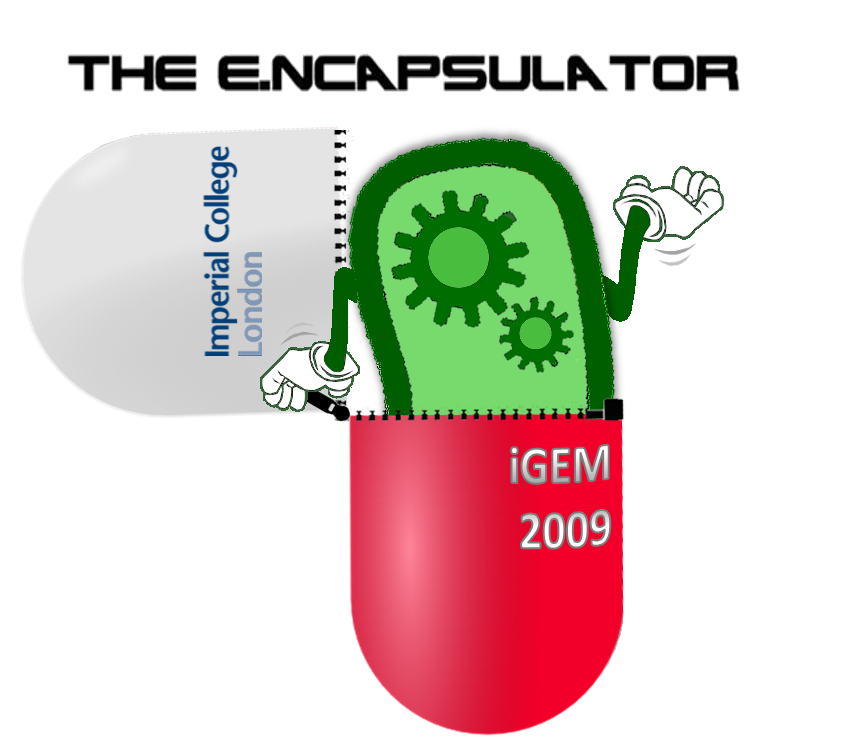Team:Imperial College London/Project2
From 2009.igem.org
| Line 5: | Line 5: | ||
A major, yet unsolved, challenge in the pharmaceutical industry involves overcoming the harsh acidic environment of the stomach in order to deliver proteins to the gut. This year the Imperial College iGEM team has decided to tackle this problem by developing an innovative, self-contained drug fabrication and delivery system. In our 'E.ncapsulator', Escherichia coli will be engineered not only to efficiently manufacture important biopharmaceuticals, but also to coat and protect protein based drugs until release in the small intestine. | A major, yet unsolved, challenge in the pharmaceutical industry involves overcoming the harsh acidic environment of the stomach in order to deliver proteins to the gut. This year the Imperial College iGEM team has decided to tackle this problem by developing an innovative, self-contained drug fabrication and delivery system. In our 'E.ncapsulator', Escherichia coli will be engineered not only to efficiently manufacture important biopharmaceuticals, but also to coat and protect protein based drugs until release in the small intestine. | ||
| - | <html></div><img src="https://static.igem.org/mediawiki/2009/b/b4/II09_content_bottom.png" width="722"><div id="II09_content" | + | <html></div><img src="https://static.igem.org/mediawiki/2009/b/b4/II09_content_bottom.png" width="722"><div id="II09_content"> |
| - | + | </div><img src="https://static.igem.org/mediawiki/2009/c/c8/II09_content_top.png" width="722"><div id="II09_content"></html> | |
| - | + | ||
Furthermore, in order to create E.ncapsulator tablets for oral delivery, there has been much focus on designing and engineering a number of modules for implementation in E. <i>coli</i>. The modularity that is central to our project will be evident in the areas of protein drug production, self-encapsulation and genome deletion. Utilising the <i>E.coli</i> bacterium, we are creating a re-usable chassis that will allow the development of a range of biopharmaceuticals to be delivered to the gut. Our E.ncapsulator is therefore intended as an elegant solution to, not one, but a range of human ailments and conditions, which cannot currently be successfully treated by oral drugs.<br> | Furthermore, in order to create E.ncapsulator tablets for oral delivery, there has been much focus on designing and engineering a number of modules for implementation in E. <i>coli</i>. The modularity that is central to our project will be evident in the areas of protein drug production, self-encapsulation and genome deletion. Utilising the <i>E.coli</i> bacterium, we are creating a re-usable chassis that will allow the development of a range of biopharmaceuticals to be delivered to the gut. Our E.ncapsulator is therefore intended as an elegant solution to, not one, but a range of human ailments and conditions, which cannot currently be successfully treated by oral drugs.<br> | ||
Revision as of 09:44, 10 September 2009

Creating ‘The E.ncapsulator’: in situ manufacture and oral delivery of human biopharmaceuticals
A major, yet unsolved, challenge in the pharmaceutical industry involves overcoming the harsh acidic environment of the stomach in order to deliver proteins to the gut. This year the Imperial College iGEM team has decided to tackle this problem by developing an innovative, self-contained drug fabrication and delivery system. In our 'E.ncapsulator', Escherichia coli will be engineered not only to efficiently manufacture important biopharmaceuticals, but also to coat and protect protein based drugs until release in the small intestine.


The first module involves engineering E. coli to synthesise the protein drug of interest to sufficient quantities. Once accomplished, activation of module two initiates the encapsulation phase, in which E. coli coats itself in a protective layer of colanic acid to form the E.ncapsulator. This protective capsule is what shields the biopharmaceutical against the harsh acidic environment of the stomach. The third module, genome deletion, is composed of a ‘suicide trigger’ mechanism that destroys the genetic material of the bacteria. Finally, once in the small intestine, the capsule will be naturally degraded by enzymes present, thereby releasing the designed biopharmaceutical to the gut micro biota where it can carry out its intended function.
The self-encapsulation of a synthetic biology chassis is new to iGEM and represents a completely novel and innovative approach to biopharmaceutical design, manufacture and delivery. Throughout the project we have followed an engineering approach that incorporates modular design, detailed modelling and simulation as well as systematic integration. Using such an approach, we are hopeful that the E.ncapsulator will be coming soon to a Pharmacy near you!
 "
"




